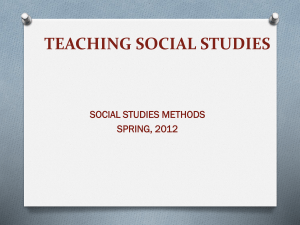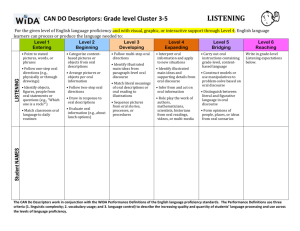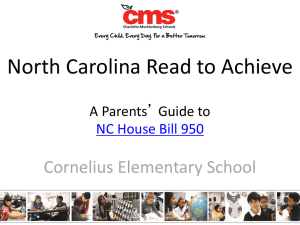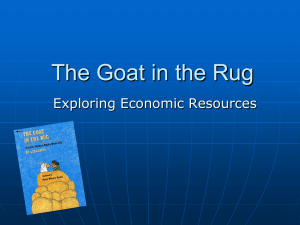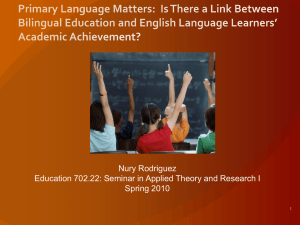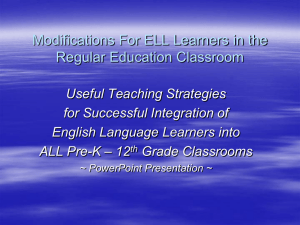New English Language Proficiency Levels
advertisement
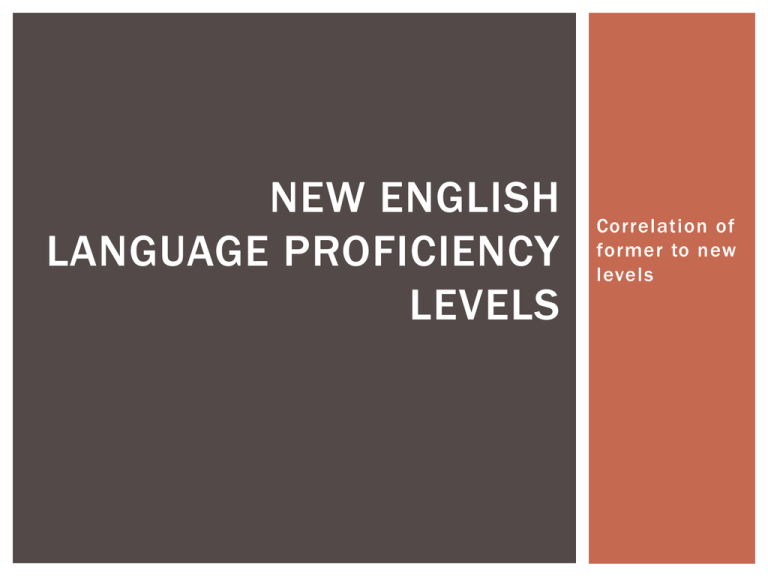
NEW ENGLISH LANGUAGE PROFICIENCY LEVELS Correlation of former to new levels NEW LEVEL 1 - STARTING Former (up to SY 11-12) Beginning to Mid Level 1 Students initially have little to no understanding of English. Stages of Language Proficiency NEW Level 1 Starting Students initially have little to no understanding of English. Pre-Production • Does not yet produce speech (silent period) • Listens and begins to respond by using nonverbal signals • Internalizes significant pieces of information • Internalizes significant pieces of information Early Production • • • • Responds with one or two words Attends to hands-on demonstrations with greater comprehension Initiates conversations by pointing and using single words Responds nonverbally to a wider range of language input DESCRIPTORS OF LANGUAGE PROFICIENCY FOR THE NEW LEVEL 1 Students initially have little to no understanding of English and rarely use English for communication. They respond nonverbally to simple commands, statements, and questions. As their oral comprehension increases, they begin to imitate the verbalizations of others by using single words or simple phrases, and they begin to use English spontaneously. At the earliest stage, these learners construct meaning from text primarily through non-print features (e.g., illustrations, graphs, maps, and tables. They gradually construct more meaning from the words themselves, but the construction is often incomplete. They are able to generate simple texts that reflect their knowledge level of syntax. These texts may include a significant amount of nonconventional features, such as invented spelling, grammatical inaccuracies, pictorial representations, and surface features and rhetorical patterns of the native language (such as replication of way of structuring text from the native culture and language.) NEW LEVEL 2 - EMERGING Former (up to SY 11-12) High Level 1 To Low to Mid Level 2 Students understand more complex speech. NEW Stages of Language Proficiency Level 2 Emerging Speech Emergence •Begins speaking in phrases and short sentences •Uses speech that sounds telegraphic: “I go home Students now.” can understand • Makes many errors of grammar and syntax as they and use phrases experiment with language and short sentences. DESCRIPTORS OF LANGUAGE PROFICIENCY FOR THE NEW LEVEL 2 Students can understand phrases and short sentences. They can communicate limited information in simple, everyday and routine situations by using memorized phrases, groups of words, and formulae. They can use selected simple structures correctly but still systematically produce basic errors. Students begin to use general academic vocabulary and familiar everyday expressions. Reading and writing proficiency may vary depending on students’ literacy development in their native language and their familiarity with the alphabet, among other factors. Students can read words and phrases, and locate specific, predictable information in simple everyday or environmental print. They often make errors in writing that hinder communication. NEW LEVEL 3 - DEVELOPING Former (up to SY 11-12) High Level 2 To Low to Mid Level 3 Students use English more spontaneously but still have difficulty expressing all their thoughts. NEW Stages of Language Proficiency Level 3 Developing Students understand and use more complex language, but still require repetition. Intermediate Fluency • Responds with a flow of related phrases and sentences • Engages in discourse • Communicates thoughts more effectively • Engages in everyday conversation without relying on concrete contextual support • Begins to develop more academic language DESCRIPTORS OF LANGUAGE PROFICIENCY FOR THE NEW LEVEL 3 Students understand more complex speech but still require repetition. They acquire a vocabulary of stock words and phrases covering many daily situations. They use English spontaneously but may have difficulty expressing all their thoughts due to a restricted vocabulary and a limited command of language structure. Students at this level speak in short, simple sentences, which are comprehensible and appropriate, but which are frequently marked by grammatical errors. Although they may understand and use some specialized academic vocabulary, they still have some trouble comprehending and producing complex structures and academic language. Proficiency in reading may vary considerably depending upon the learners’ familiarity and prior experiences with themes, concepts, or genres. . They are most successful constructing meaning from texts for which they have background knowledge upon which to build. In writing, they are able to generate more complex texts, a wider variety of texts, and more coherent texts that are learners at the Starting and Emerging levels. Texts will have considerable numbers of nonconventional features. NEW LEVEL 4 - EXPANDING Former (up to SY 11-12) High Level 3 To Low to Mid Level 4 Students’ language skills are adequate for most day-to-day communication needs. NEW Stages of Language Proficiency Level 4 Advanced Fluency Expanding •Responds with a flow of related phrases and sentences •Participates in reading and writing activities to acquire new information •Demonstrates increased levels of accuracy and Students’ correctness and is able to express thoughts and feelings language skills •Produces language with varied grammatical structures are adequate and vocabulary for most social •May experience difficulties in abstract, cognitively and some demanding subjects academic needs. DESCRIPTORS OF LANGUAGE PROFICIENCY FOR THE NEW LEVEL 4 Students’ language skills are adequate for most day-to-day communication needs. Occasional structural and lexical errors occur. Students may have difficulty understanding and using some idioms, figures of speech, and words with multiple meanings. They communicate in English in new or unfamiliar settings but have occasional difficulty with complex structures and abstract academic concepts. Students at this level may read with considerable fluency and are able to locate and identify the specific facts within the text. However, they may not understand texts in which the concepts are presented in a decontextualized manner, the sentence structure is complex, or the vocabulary is abstract or has multiple meanings. They can read independently but may have occasional comprehension problems, especially when processing grade-level information. Although students can produce texts independently for personal and academic purposes, they encounter more difficulty with grade-level literacy than with oral language. Structures, vocabulary, and overall organization begin to approximate the writing of native speakers of English. Errors, however, may persist in one or more language domains, but they generally do not interfere with communication. NEW LEVEL 5 - BRIDGING Former (up to SY 11-12) High Level 4 NEW Stages of Language Proficiency Level 5 Bridging Near Native Fluency •Approaching full English proficiency Students can •Needs sustained, pinpointed instruction to polish and Students’ express perfect English proficiency across all domains language themselves •Exhibits linguistic behaviors that are nearly within the skills closely fluently and range of grade-level performance of English language approximate spontaneously proficient students grade level but are not •Occasional structural and lexical errors may occur. peers for necessarily •May encounter difficulties with academic language at most social English higher grades due to rigorous curriculum and academic proficient. needs. DESCRIPTORS OF LANGUAGE PROFICIENCY FOR THE NEW LEVEL 5 Students at this level are not necessarily fully English proficient, especially across all language domains and all standards. Students can express themselves fluently and spontaneously on a wide range of personal, general, academic, or social topics in a variety of contexts. They are poised to function in an environment with native speaking peers with minimal language support or guidance. At this level, students are able to work with grade-level materials with some modification. They have a good command of technical and academic vocabulary as well of idiomatic expressions and colloquialisms. They can produce clear, smoothly flowing, well-structured texts of differing lengths and degrees of linguistic complexity. Errors are minimal, may be difficult to spot, and are generally corrected when they occur. NEW LEVEL 6 EXITED THE ESL PROGRAM Former (up to SY 11-12) Level 5 Student exited the ESL Program OR Student Has a language other than English but is on par with grade-level peers NEW Stages of Language Proficiency Level 6 The student received ESL services and support, but is now on par with grade-level peers and no longer requires support from the ESL Program. A student who has been exited from the program may be re-enrolled if additional ESL support is indicated at a later date. It is advisable to monitor Level 6 ELLs as they progress through grade levels. LEVEL 7 PARENT DECLINED ESL SERVICES Former NEW Stages of Language Proficiency Level 7 Level 7 Parent Declined ESL Services Parent Declined ESL Services A student at level 1, 2, 3, 4 or 5, but whose parents have declined assessment and/or services of the ESL program. (up to SY 11-12) NOTE: If the parent has not declined assessment, the level 7 ELL will be re- assessed during annual monitoring of student progress each spring. NEW LEVEL 8 NO ESL SERVICES REQUIRED Former (up to SY 11-12) Level 5 Student exited the ESL Program OR Student has a language other than English but is on par with grade-level peers NEW Stages of Language Proficiency Level 8 The student has a language other than English in his/her background, but is on par with grade-level peers and does not require support from the ESL Program. A Level 8 student who later indicates a need for ESL services may be assessed and enrolled in the program if needed. DIFFERENTIATING FOR ELLS The differentiation process for ELLs requires knowing the basics of both intercultural communication and the language acquisition process, including the characteristics of each stage of language development. The ability to recognize and meaningfully address the range of students capabilities at each level of developing English language proficiency is the key to English language learner (ELL) differentiation.
